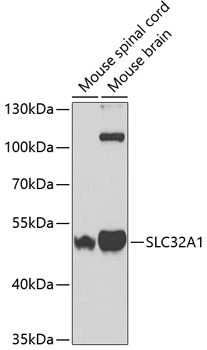VGAT antibody [N1N2], N-term
GTX101908
ApplicationsImmunoFluorescence, Western Blot, ImmunoCytoChemistry, ImmunoHistoChemistry, ImmunoHistoChemistry Frozen, ImmunoHistoChemistry Paraffin
Product group Antibodies
TargetSLC32A1
Overview
- SupplierGeneTex
- Product NameVGAT antibody [N1N2], N-term
- Delivery Days Customer9
- Application Supplier NoteWB: 1:1000-1:10000. ICC/IF: 1:100-1:1000. IHC-P: 1:100-1:1000. IHC-Fr: 1:100-1:1000. *Optimal dilutions/concentrations should be determined by the researcher.Not tested in other applications.
- ApplicationsImmunoFluorescence, Western Blot, ImmunoCytoChemistry, ImmunoHistoChemistry, ImmunoHistoChemistry Frozen, ImmunoHistoChemistry Paraffin
- CertificationResearch Use Only
- ClonalityPolyclonal
- Concentration0.52 mg/ml
- ConjugateUnconjugated
- Gene ID140679
- Target nameSLC32A1
- Target descriptionsolute carrier family 32 member 1
- Target synonymsGABA and glycine transporter; hVIAAT; solute carrier family 32 (GABA vesicular transporter), member 1; vesicular GABA transporter; vesicular inhibitory amino acid transporter; VGAT; VIAAT
- HostRabbit
- IsotypeIgG
- Protein IDQ9H598
- Protein NameVesicular inhibitory amino acid transporter
- Scientific DescriptionThe protein encoded by this gene is an integral membrane protein involved in gamma-aminobutyric acid (GABA) and glycine uptake into synaptic vesicles. The encoded protein is a member of amino acid/polyamine transporter family II. [provided by RefSeq]
- Storage Instruction-20°C or -80°C,2°C to 8°C
- UNSPSC12352203
References
- Loss of putative GABAergic neurons in the ventrolateral medulla in multiple system atrophy. Schmeichel AM et al., 2021 Sep 13, SleepRead more
- Ataxic phenotype and neurodegeneration are triggered by the impairment of chaperone-mediated autophagy in cerebellar neurons. Sato M et al., 2021 Feb, Neuropathol Appl NeurobiolRead more





